Middleton W.M. (ed.) Reference Data for Engineers: Radio, Electronics, Computer and Communications
Подождите немного. Документ загружается.

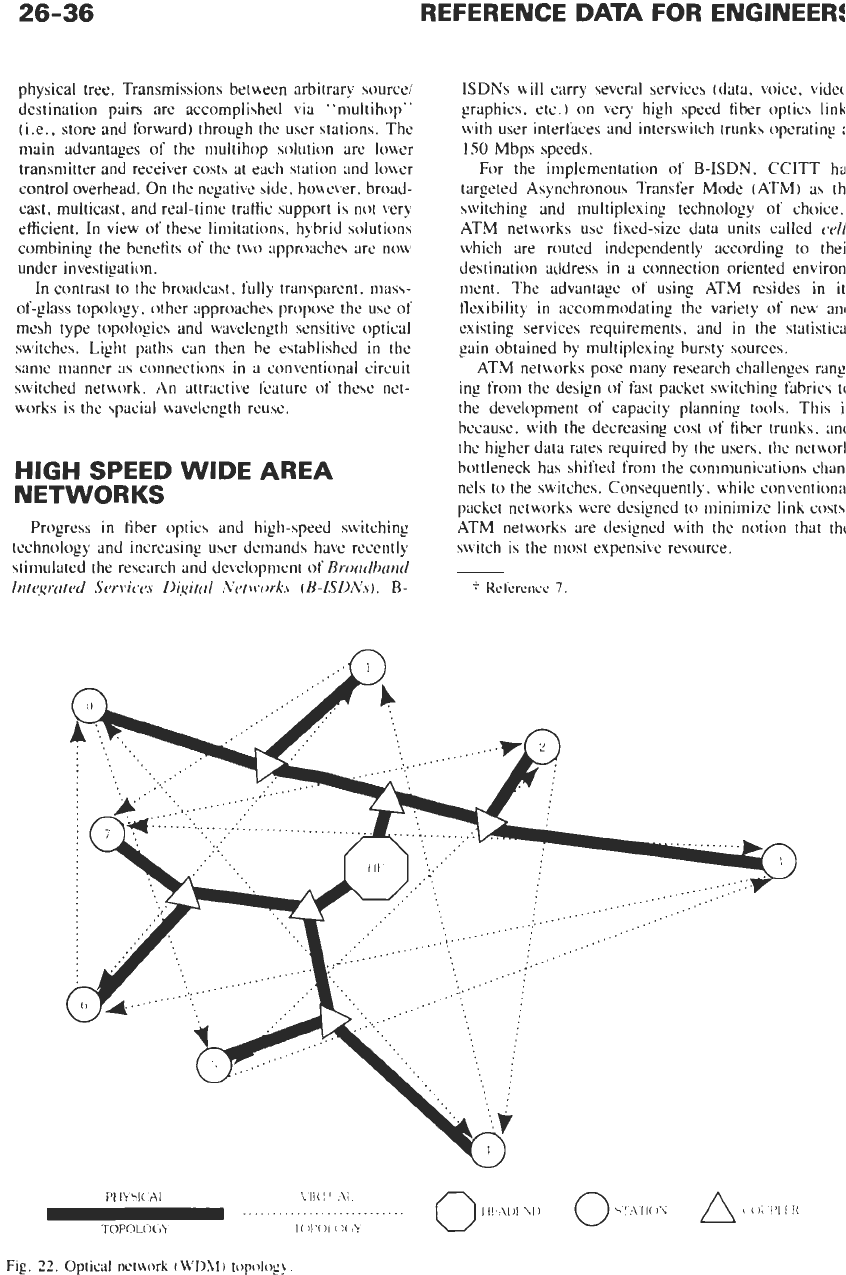
26-36
REFERENCE
DATA
FOR ENGINEER!
physical
tree.
Transmissions between arbitrary source/
destination pairs are accomplished via “multihop”
(i.e..
store and forward) through the user stations. The
main advantages of the multihop solution are
lower
transmitter and receiver costs at each station and lower
control overhead.
On
the negative side, however, broad-
cast, multicast, and real-time traffic support
is
not very
efficient.
In
view of these limitations, hybrid solutions
combining the benefits of the two approaches are now
under investigation.
In
contrast to the broadcast, fully transparent, mass-
of-glass topology, other approaches propose the use
of
mesh type topologies and wavelength sensitive optical
switches. Light paths can then
be
established in the
same manner as connections in a conventional circuit
switched netwrk. An attractive feature of these net-
works is the spacial wavelength reuse.
HIGH
SPEED WIDE AREA
NETWORKS
Progress in fiber optics and high-speed switching
technology and increasing user demands have recently
stimulated the research and development of
Broadband
Integrated Services Digital Netnorks (B-ISDNs).
B-
ISDNs
will carry several services (data, voice, videc
graphics, etc.)
on
very high speed
fiber
optics
link
with user interfaces and interswitch trunks operating
i
150
Mbps speeds.
For the implementation of
B-ISDN,
CCITT ha
targeted Asynchronous Transfer Mode (ATM) as
th
switching and multiplexing technology
of
choice.
ATM networks use fixed-size data units called
cell
which are routed independently according to thei
destination address in a connection oriented environ
ment. The advantage of using ATM resides in it
flexibility in accommodating the variety of new ant
existing services requirements, and in the statistica
gain obtained by multiplexing bursty sources.
ATM networks pose many research challenges rang
ing from the design of fast packet switching fabrics tc
the development
of
capacity planning tools. This
i
because, with the decreasing cost of
fiber
trunks, an(
the higher data rates required by the users, the networl
bottleneck has shifted from the communications chan
nets to the switches. Consequently, while conventiona
packet networks
were
designed to minimize link costs
ATM networks
are
designed with the notion that thc
switch is the most expensive resource.
f
Reference
7.
W
PHYSICAL
VlRTl
‘AL
TOI’OI
O(s1
TOPOLOGY
’-
...........................
0
t+CZDEND
0
STATIOS
A
COI’PLLR
Fig.
22.
Optical
network
(WDM)
topology.
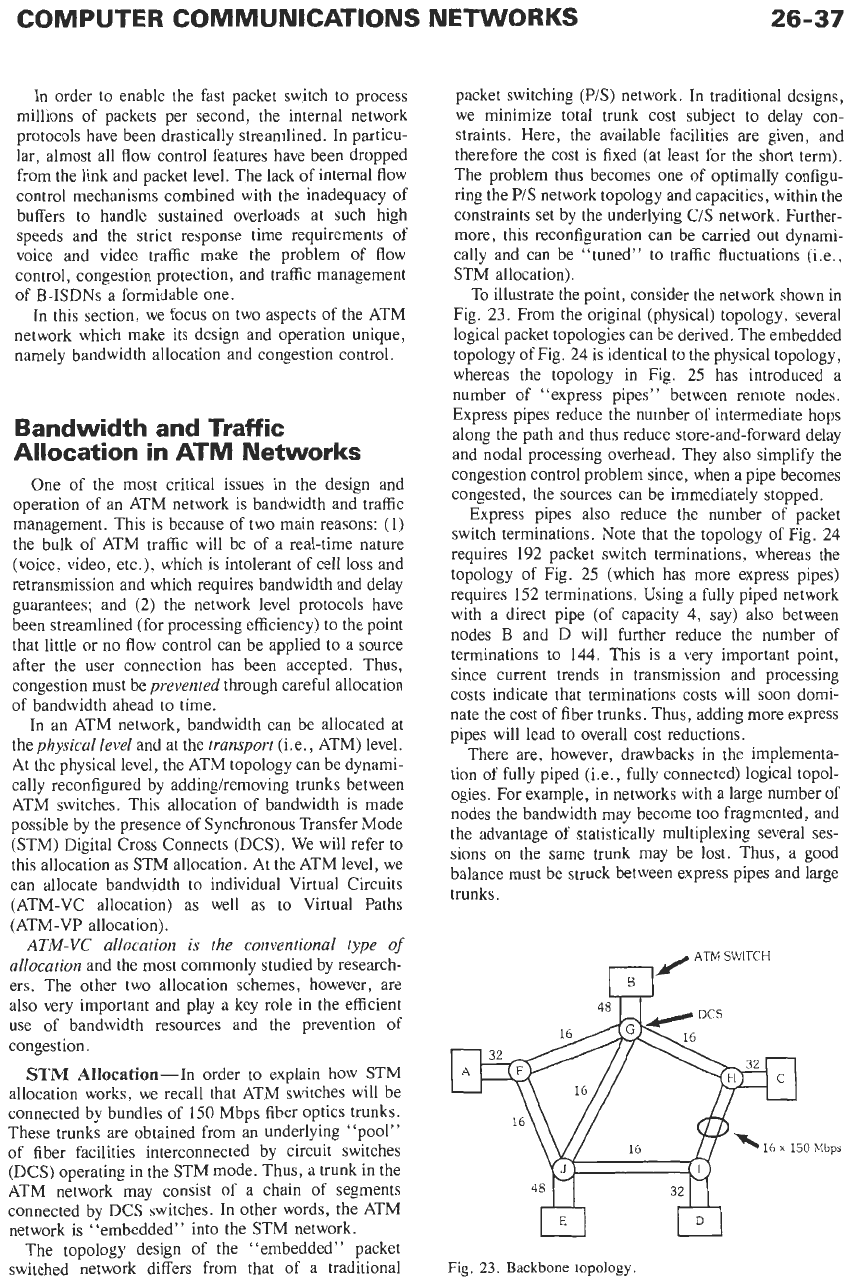
26-37
In order to enable the fast packet switch to process
millions of packets per second, the internal network
protocols have been drastically streamlined. In particu-
lar, almost all flow control features have been dropped
from the link and packet level. The lack
of
internal flow
control mechanisms combined with the inadequacy of
buffers to handle sustained overloads at such high
speeds and the strict response time requirements of
voice and video traffic make the problem of flow
control, congestion protection, and traffic management
of
B-ISDNs
a formidable one.
In this section, we focus on two aspects of the ATM
network which make its design and operation unique,
namely bandwidth allocation and congestion control.
Bandwidth and Traffic
Allocation in
ATM
Networks
One of the most critical issues in the design and
operation of an ATM network is bandwidth and traffic
management. This is because of two main reasons:
(1)
the bulk
of
ATM traffic will be of a real-time nature
(voice: video, etc.), which is intolerant of cell
loss
and
retransmission and which requires bandwidth and delay
guarantees; and
(2)
the network level protocols have
been streamlined (for processing efficiency) to the point
that little or no flow control can be applied to a source
after the user connection has been accepted. Thus,
congestion must be
prevented
through careful allocation
of bandwidth ahead to time.
In an ATM network, bandwidth can be allocated at
the
physical level
and at the
transport
(Le., ATM) level.
At the physical level, the ATM topology can be dynami-
cally reconfigured by addingiremoving trunks between
ATM switches. This allocation of bandwidth is made
possible by the presence of Synchronous Transfer Mode
(STM) Digital Cross Connects (DCS). We will refer to
this allocation as STM allocation. At the ATM level, we
can allocate bandwidth
to
individual Virtual Circuits
(ATM-VC allocation) as well as to Virtual Paths
(ATM-VP allocation).
ATM-VC
allocation
is
the conventional type
of
allocation
and the most commonly studied by research-
ers. The other two allocation schemes, however, are
also very important and play a key role in the efficient
use of bandwidth resources and the prevention of
congestion.
STM
Allocation-In order to explain
how
STM
allocation works, we recall that ATM switches will be
connected by bundles
of
150
Mbps fiber optics trunks.
These trunks are obtained from an underlying “pool”
of
fiber facilities interconnected by circuit switches
(DCS) operating in the STM mode. Thus, a trunk in the
ATM network may consist of a chain of segments
connected by DCS switches. In other words, the ATM
network is “embedded” into the STM network.
The topology design of the “embedded” packet
switched network differs from that of a traditional
packet switching
(P/S)
network. In traditional designs,
we minimize total trunk cost subject
to
delay con-
straints. Here, the available facilities are given, and
therefore the cost is fixed (at least for the short term).
The problem thus becomes one
of
optimally configu-
ring the
PIS
network topology and capacities, within the
constraints set by the underlying CIS network. Further-
more, this reconfiguration can be carried out dynami-
cally and can be “tuned” to traffic fluctuations (i.e.,
STM allocation).
To
illustrate the point, consider the network shown in
Fig.
23.
From the original (physical) topology, several
logical packet topologies can be derived. The embedded
topology of Fig.
24
is identical to the physical topology,
whereas the topology in Fig.
25
has introduced a
number of “express pipes” between remote nodes.
Express pipes reduce the number of intermediate hops
along the path and thus reduce store-and-forward delay
and nodal processing overhead. They also simplify the
congestion control problem since, when a pipe becomes
congested, the sources can be immediately stopped.
Express pipes also reduce the number of packet
switch terminations. Note that the topology of Fig.
24
requires
192
packet switch terminations. whereas the
topology
of
Fig.
25
(which has more express pipes)
requires
152
terminations. Using a fully piped network
with a direct pipe (of capacity
4,
say) also between
nodes
B
and D will further reduce the number of
terminations to
144.
This is a very important point,
since current trends in transmission and processing
costs indicate that terminations costs will soon domi-
nate the cost of fiber trunks. Thus, adding more express
pipes will lead to overall cost reductions.
There are, however, drawbacks in the implementa-
tion of fully piped (i.e., fully connected) logical topol-
ogies. For example, in networks with a large number of
nodes the bandwidth may become too fragmented, and
the advantage of statistically multiplexing several ses-
sions on the same trunk may be lost. Thus, a good
balance must be struck between express pipes and large
trunks.
Fig.
23.
Backbone
topology
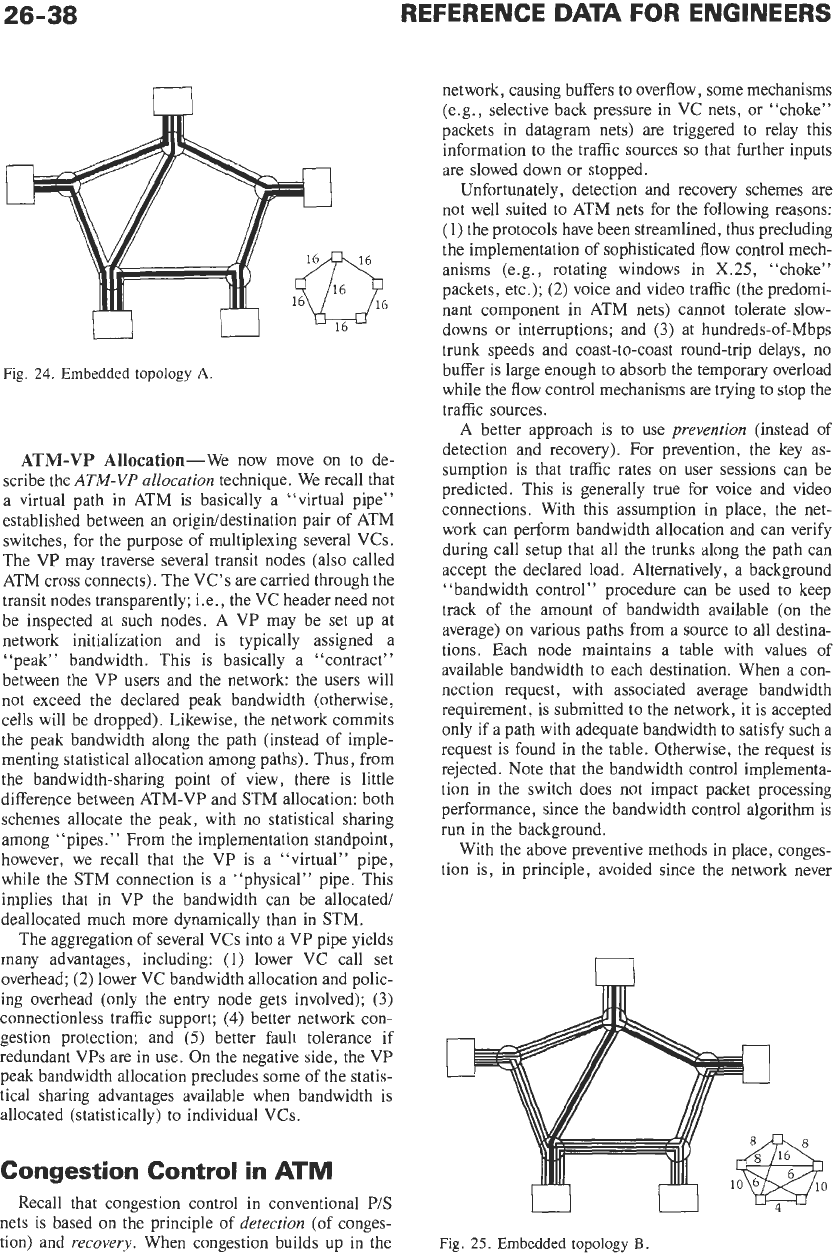
26-38
network, causing buffers to overflow, some mechanisms
(e.g., selective back pressure in VC nets, or “choke”
packets in datagram nets) are triggered to relay this
information to the traffic sources
so
that further inputs
are slowed down or stopped.
Unfortunately, detection and recovery schemes are
not well suited to ATM nets for the following reasons:
(1) the protocols have been streamlined, thus precluding
the implementation of sophisticated flow control mech-
anisms (e.g., rotating windows in
X.25,
“choke”
packets, etc.);
(2)
voice and video traffic (the predomi-
nant component in ATM nets) cannot tolerate slow-
downs or interruptions; and
(3)
at hundreds-of-Mbps
trunk speeds and coast-to-coast round-trip delays, no
buffer is large enough to absorb the temporary overload
while the flow control mechanisms are trying to stop the
traffic sources.
A better approach is to use prevention (instead of
detection and recovery). For prevention, the key as-
sumption is that traffic rates on user sessions can be
predicted.
This
is
true
for
voice
and
video
connections. With this assumption in place, the net-
work can
perform
bandwidth
allocation
and
can
verify
during call setup that all the trunks along the path can
Fig.
24.
Embedded
topology
A.
ATM-VP
A1location-we
now
move
On
to
de-
scribe the
ATM-VP
allocution technique. We recall that
a virtual path in ATM is basically a “virtual pipe”
established between an origiddestination pair of ATM
switches, for the purpose of multiplexing several VCs.
The
vp
may
traverse
several
transit
nodes
accept the declared load. Alternatively,
a
background
ATM CrOSS Connects). The VC’S are carried through the
‘‘bandwidth
control^
I
procedure
can
be
used
to
keep
track
of
the amount of bandwidth available (on the
average) on various paths from a source
to
all destina-
tions. Each node maintains a table with values of
available bandwidth to each destination. When a con-
nection
request,
with
associated
average
bandwidth
only
if
a path with adequate bandwidth
to
satisfy
such
a
rejected. Note that the bandwidth control implementa-
tion in the switch does not impact packet processing
performance,
since
the
bandwidth
control
algorithm
is
run
in
the
background,
With the above preventive methods in place, conges-
tion is, in principle, avoided since the network never
transit nodes transparently; Le., the VC header need not
be
inspected
at
such
nodes’
A
vp
may
be
set
up
at
network initialization and is typically assigned a
“peak” bandwidth. This is basically a “contract”
between the VP users and the network: the users will
cells will be dropped). Likewise, the network commits
not
exceed
the
peak
bandwidth
(Otherwise,
requirement, is submitted to the network, it
is
accepted
the
peak
bandwidth
the
path (instead
Of
request is found in the table. Otherwise, the request
is
rnenting statistical allocation among paths). Thus, from
the bandwidth-sharing point
of
view, there is little
difference between ATM-VP and STM allocation: both
schemes allocate the peak, with no statistical sharing
among “pipes.” From the implementation standpoint,
however, we recall that the VP is a “virtual” pipe,
while the STM connection is a “physical” pipe. This
implies that in VP the bandwidth can be allocated/
deallocated much more dynamically than in STM.
The aggregation of several VCs into a VP pipe yields
many advantages, including:
(1)
lower VC call set
overhead;
(2)
lower VC bandwidth allocation and polic-
ing overhead (only the entry node gets involved);
(3)
connectionless traffic support;
(4)
better network con-
gestion protection; and
(5)
better fault tolerance if
redundant VPs are in use. On the negative side, the VP
peak bandwidth allocation precludes some of the statis-
tical sharing advantages available when bandwidth is
allocated (statistically) to individual VCs.
Congestion Control in
ATM
Recall that congestion control in conventional P/S
nets is based on the principle
of
detection (of conges-
tion) and
recovery.
When congestion builds up in the
Fig.
25.
Embedded
topology
B.
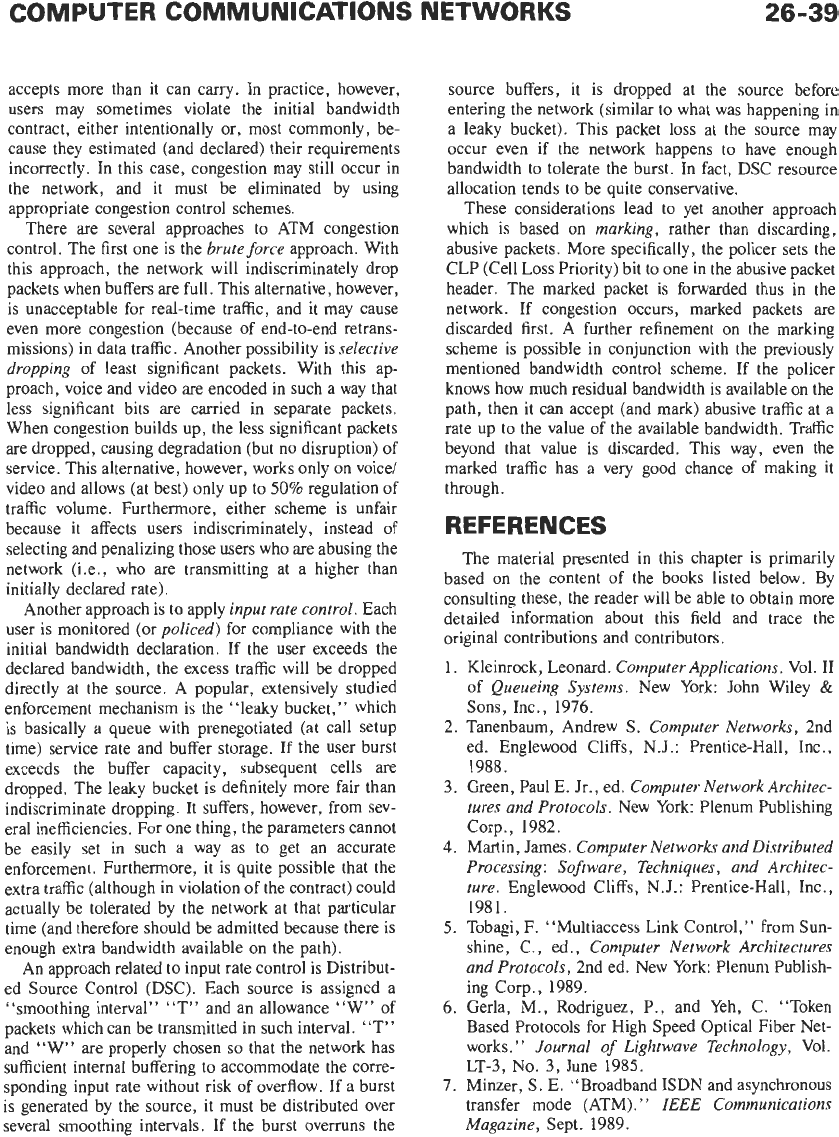
accepts more than it can carry. In practice, however,
users may sometimes violate the initial bandwidth
contract, either intentionally or, most commonly, be-
cause they estimated (and declared) their requirements
incorrectly. In this case, congestion may still occur in
the network, and it must be eliminated by using
appropriate congestion control schemes.
There are several approaches to ATM congestion
control. The first one is the
brute force
approach. With
this approach, the network will indiscriminately drop
packets when buffers are full. This alternative, however,
is unacceptable for real-time traffic, and it may cause
even more congestion (because of end-to-end retrans-
missions) in data traffic. Another possibility is
selective
dropping
of least significant packets. With this ap-
proach, voice and video are encoded in such a way that
less significant bits are carried in separate packets.
When congestion builds up, the less significant packets
are dropped, causing degradation (but no disruption) of
service. This alternative, however, works only on voice/
video and allows (at best) only up to
50%
regulation of
traffic volume. Furthermore, either scheme is unfair
because it affects users indiscriminately, instead of
selecting and penalizing those users who are abusing the
network (i.e., who are transmitting at a higher than
initially declared rate).
Another approach
is
to apply
input rate control.
Each
user is monitored (or
policed)
for compliance with the
initial bandwidth declaration. If the user exceeds the
declared bandwidth, the excess traffic will be dropped
directly at the source. A popular, extensively studied
enforcement mechanism is the “leaky bucket,” which
is basically a queue with prenegotiated (at call setup
time) service rate and buffer storage. If the user burst
exceeds the buffer capacity, subsequent cells are
dropped. The leaky bucket is definitely more fair than
indiscriminate dropping. It suffers, however, from sev-
eral inefficiencies. For one thing, the parameters cannot
be easily set in such a way as to get an accurate
enforcement. Furthermore, it is quite possible that the
extra traffic (although in violation of the contract) could
actually be tolerated by the network at that particular
time (and therefore should be admitted because there is
enough extra bandwidth available on the path).
An approach related to input rate control is Distribut-
ed Source Control (DSC). Each source is assigned a
“smoothing interval”
“T”
and an allowance “W” of
packets which can be transmitted in such interval.
“T”
and “W” are properly chosen
so
that the network has
sufficient internal buffering to accommodate the corre-
sponding input rate without risk of overflow. If a burst
is
generated by the source, it must be distributed over
several smoothing intervals. If the burst overruns the
source buffers, it is dropped at the source before
entering the network (similar to what was happening in
a leaky bucket). This packet loss at the source may
occur even if the network happens to have enough
bandwidth to tolerate the burst. In fact, DSC resource
allocation tends to be quite conservative.
These considerations lead to yet another approach
which
is
based on
marking,
rather than discarding,
abusive packets. More specifically, the policer sets the
CLP (Cell
Loss
Priority) bit to one in the abusive packet
header. The marked packet is forwarded thus in the
network. If congestion occurs, marked packets are
discarded first.
A
further refinement on the marking
scheme is possible in conjunction with the previously
mentioned bandwidth control scheme. If the policer
knows how much residual bandwidth is available on the
path, then it can accept (and mark) abusive traffic at a
rate up to the value of the available bandwidth. Traffic
beyond that value is discarded. This way, even the
marked traffic has a very good chance of making it
through.
REFERENCES
The material presented in this chapter is primarily
based on the content of the books listed below. By
consulting these, the reader will be able
to
obtain more
detailed information about this field and trace the
original contributions and contributors.
1.
Kleinrock, Leonard.
Computer Applications.
Vol.
I1
of
Queueing Systems.
New York: John Wiley
&
Sons, Inc., 1976.
2. Tanenbaum, Andrew
S.
Computer Networks,
2nd
ed. Englewood Cliffs, N.J.: Prentice-Hall, Inc.,
1988.
3.
Green, Paul
E.
Jr., ed.
Computer Network Architec-
tures and Protocols.
New York: Plenum Publishing
Corp., 1982.
4.
Martin, James.
Computer Networks and Distributed
Processing: Software, Techniques, and Architec-
ture.
Englewood Cliffs,
N.J.:
Prentice-Hall, Inc.,
1981.
5.
Tobagi,
F.
“Multiaccess Link Control,” from Sun-
shine, C., ed.,
Computer Network Architectures
and Protocols,
2nd ed. New York Plenum Publish-
ing Corp., 1989.
6.
Gerla, M., Rodriguez, P., and Yeh, C. “Token
Based Protocols for High Speed Optical Fiber Net-
works.’’
Journal
of
Lightwave Technology,
Vol.
LT-3,
No.
3,
June 1985.
7.
Minzer,
S.
E.
“Broadband
ISDN
and asynchronous
transfer mode (ATM).”
ZEEE
Communications
Magazine,
Sept. 1989.

27
Satellite and Space
Communications
~
~ ~~
~
~~
Geoffrey Hyde and Pier
L.
Bargellini
Evolution
of
Communication Satellite Systems and
Their Role in Worldwide Communications
27-4
Satellite Orbits
27-6
Information Transmission
in
Space
27-7
The Choice of the Orbit
Solar Eclipses
27-9
Nongeostationary Orbits
27-11
Elevation and Azimuth Angles
27-11
The Choice
of
Frequency
27-12
Link Budgets
27-13
Spacecraft Architecture
27-14
Transponders
27-15
Overall Transmission System Considerations
27-19
27-8
27-1
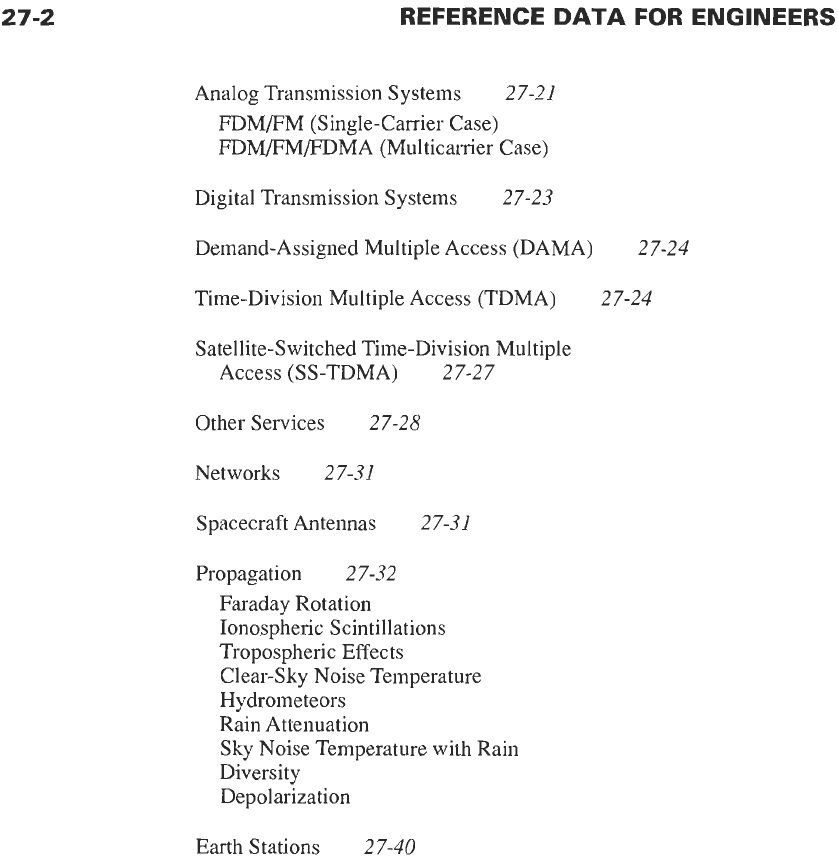
27-2
REFERENCE
DATA
FOR ENGINEERS
Analog Transmission Systems
27-21
FDM/FM (Single-Carrier Case)
FDM/FM/FDMA (Multicarrier Case)
Digital Transmission Systems
27-23
Demand-Assigned Multiple Access (DAMA)
27-24
Time-Division Multiple Access (TDMA)
27-24
Satellite-Switched Time-Division Multiple
Access (SS-TDMA)
27-27
Other Services
27-28
Networks
27-32
Spacecraft Antennas
27-31
Propagation
2 7-32
Faraday Rotation
Ionospheric Scintillations
Tropospheric Effects
Clear-Sky Noise Temperature
Hydrometeors
Rain Attenuation
Sky Noise Temperature with Rain
Diversity
Depolarization
Earth Stations
27-40
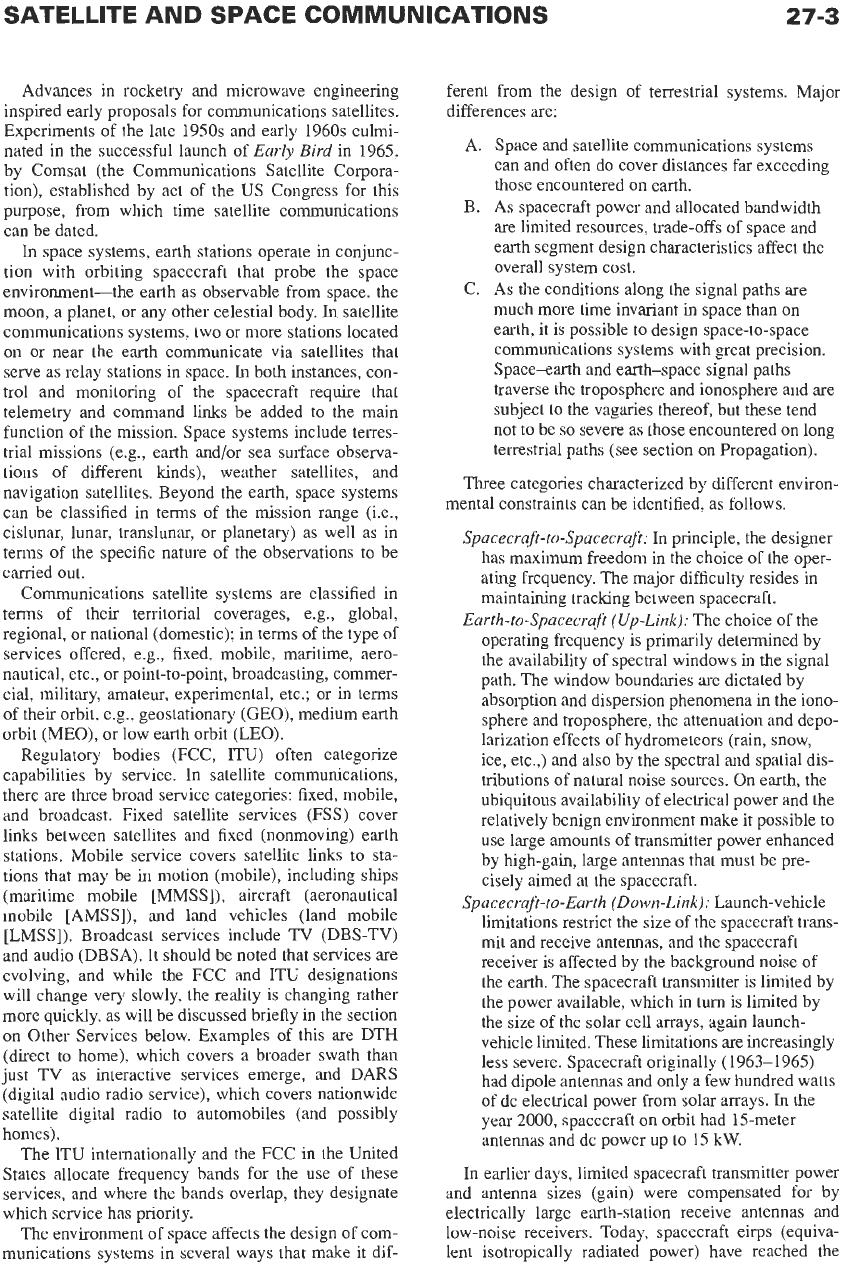
SATELLITE AND SPACE COMMUNICATIONS
27-3
Advances in rocketry and microwave engineering
inspired early proposals for communications satellites.
Experiments of the late 1950s and early 1960s culmi-
nated in the successful launch of
Early Bird
in 1965,
by Comsat (the Communications Satellite Corpora-
tion), established by act of the US Congress for this
purpose, from which time satellite communications
can be dated.
In
space systems, earth stations operate in conjunc-
tion with orbiting spacecraft that probe the space
environment-the earth as observable from space, the
moon,
a
planet, or any other celestial body.
In
satellite
communications systems, two or more stations located
on or near the earth communicate via satellites that
serve as relay stations in space.
In
both instances, con-
trol and monitoring of the spacecraft require that
telemetry and command links be added to the main
function of the mission. Space systems include terres-
trial missions (e.g., earth and/or sea surface observa-
tions of different kinds), weather satellites, and
navigation satellites. Beyond the earth, space systems
can be classified in terms of the mission range (i.e.,
cislunar, lunar, translunar, or planetary)
as
well
as
in
terms of the specific nature of the observations to be
canied
out.
Communications satellite systems are classified in
terms of their territorial coverages, e.g., global,
regional, or national (domestic); in terms of the type of
services offered, e.g., fixed, mobile, maritime, aero-
nautical, etc., or point-to-point, broadcasting, commer-
cial, military, amateur, experimental, etc.; or in terms
of their orbit, e.g., geostationary (GEO), medium earth
orbit
(MEO),
or low earth orbit (LEO).
Regulatory bodies (FCC, ITU) often categorize
capabilities by service. In satellite communications,
there are three broad service categories: fixed, mobile,
and broadcast. Fixed satellite services
(FSS)
cover
links between satellites and fixed (nonmoving) earth
stations. Mobile service covers satellite links to sta-
tions that may be in motion (mobile), including ships
(maritime mobile [MMSS]), aircraft (aeronautical
mobile [AMSS]), and land vehicles (land mobile
[LMSS]).
Broadcast services include TV (DBS-TV)
and audio (DBSA). It should be noted that services are
evolving, and while the FCC and ITU designations
will change very slowly, the reality is changing rather
more quickly,
as
will be discussed briefly in the section
on Other Services below. Examples of this are DTH
(direct to home), which covers a broader swath than
just TV as interactive services emerge, and DARS
(digital audio radio service), which covers nationwide
satellite digital radio to automobiles (and possibly
homes).
The ITU internationally and the FCC in the United
States allocate frequency bands for the use of these
services, and where the bands overlap, they designate
which service has priority.
The environment of space affects the design of com-
munications systems in several ways that make it dif-
ferent from the design of terrestrial systems. Major
differences are:
A.
B.
C.
Space and satellite communications systems
can and often do cover distances far exceeding
those encountered on earth.
As
spacecraft power and allocated bandwidth
are limited resources, trade-offs of space and
earth segment design characteristics affect the
overall system cost.
As
the conditions along the signal paths are
much more time invariant in space than on
earth, it is possible to design space-to-space
communications systems with great precision.
Space+arth and earth-space signal paths
traverse the troposphere and ionosphere and are
subject
to
the vagaries thereof, but these tend
not to be
so
severe
as
those encountered on long
terrestrial paths (see section on Propagation).
Three categories characterized by different environ-
mental constraints can be identified, as follows.
Spacecraft-to-Spacecraft:
In principle, the designer
has maximum freedom in the choice of the oper-
ating frequency. The major difficulty resides in
maintaining tracking between spacecraft.
Earth-to-Spacecraft (Up-Link):
The choice of the
operating frequency is primarily determined by
the availability of spectral windows in the signal
path. The window boundaries are dictated by
absorption and dispersion phenomena in the iono-
sphere and troposphere, the attenuation and depo-
larization effects of hydrometeors (rain, snow,
ice, etc.,) and also by the spectral and spatial dis-
tributions of natural noise sources. On earth, the
ubiquitous availability of electrical power and the
relatively benign environment make it possible
to
use large amounts of transmitter power enhanced
by high-gain, large antennas that must be pre-
cisely aimed at the spacecraft.
Spacecraft-to-Earth (Down-Link)
:
Launch-vehicle
limitations restrict the size of the spacecraft trans-
mit and receive antennas, and the spacecraft
receiver is affected by the background noise of
the earth. The spacecraft transmitter is limited by
the power available, which in turn is limited by
the size of the solar cell arrays, again launch-
vehicle limited. These limitations are increasingly
less severe. Spacecraft originally (1963-1965)
had dipole antennas and only
a
few hundred watts
of
dc electrical power from solar arrays.
In
the
year
2000,
spacecraft on orbit had 15-meter
antennas and dc power up to 15 kW.
In earlier days, limited spacecraft transmitter power
and antenna sizes (gain) were compensated for by
electrically large earth-station receive antennas and
low-noise receivers. Today, spacecraft eirps (equiva-
lent isotropically radiated power) have reached the
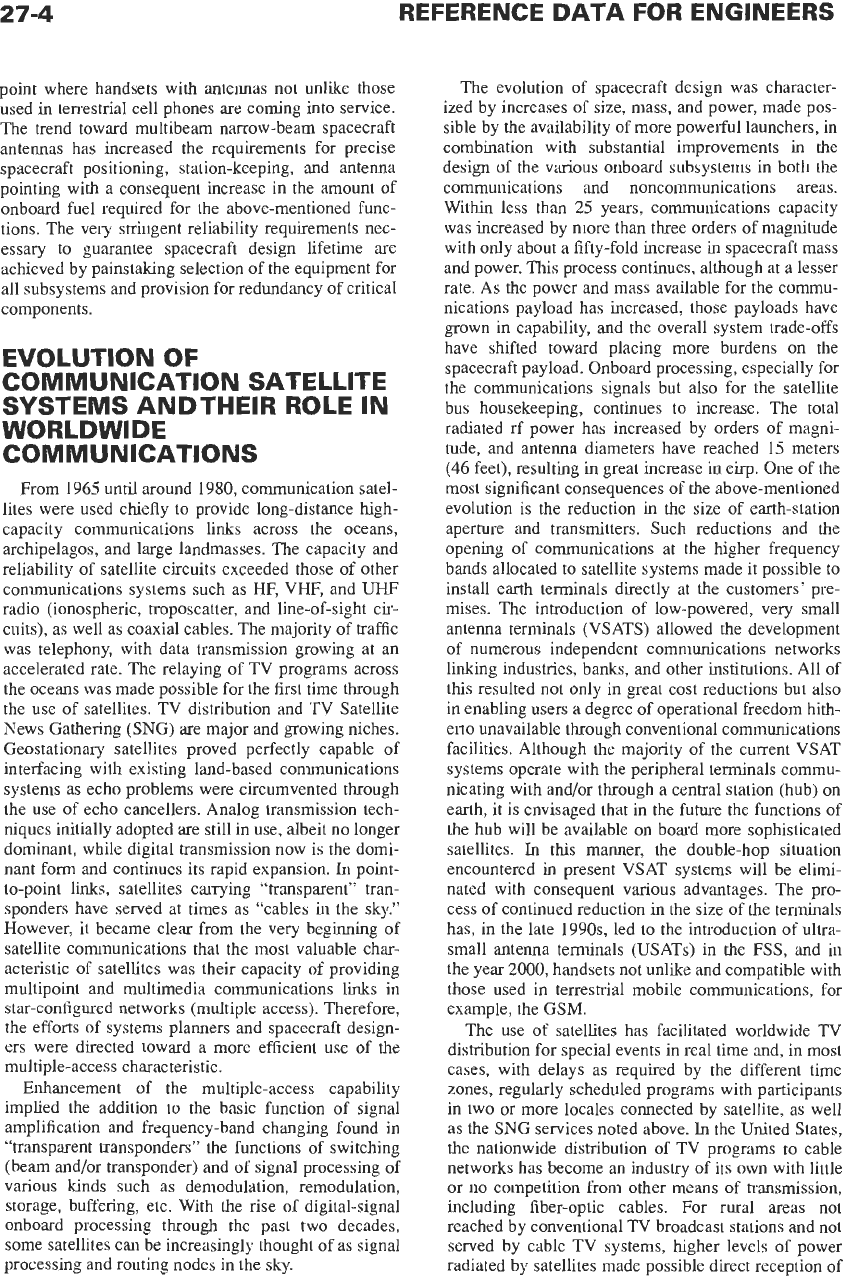
27-4
point where handsets with antennas
not
unlike those
used in terrestrial cell phones are coming into service.
The trend toward multibeam narrow-beam spacecraft
antennas has increased the requirements for precise
spacecraft positioning, station-keeping, and antenna
pointing with a consequent increase in
the
amount of
onboard fuel required for the above-mentioned func-
tions. The very stringent reliability requirements nec-
essary to guarantee spacecraft design lifetime are
achieved by painstaking selection of the equipment for
all subsystems and provision for redundancy of critical
components.
EVOLUTION
OF
COMMUNICATION SATELLITE
SYSTEMS ANDTHEIR ROLE
IN
WORLDWIDE
COMMUNICATIONS
From 1965 until around 1980, communication satel-
lites were used chiefly to provide long-distance high-
capacity communications links across the oceans,
archipelagos, and large landmasses. The capacity and
reliability of satellite circuits exceeded those of other
communications systems such as HF, VHF, and UHF
radio (ionospheric, troposcatter, and line-of-sight cir-
cuits), as well
as
coaxial cables. The majority of traffic
was telephony, with data transmission growing at an
accelerated rate. The relaying of TV programs across
the oceans was made possible for the first time through
the use of satellites. TV distribution and TV Satellite
News Gathering
(SNG)
are major and growing niches.
Geostationary satellites proved perfectly capable of
interfacing with existing land-based communications
systems as echo problems were circumvented through
the use of echo cancellers. Analog transmission tech-
niques initially adopted are still in use, albeit no longer
dominant, while digital transmission now is the domi-
nant form and continues its rapid expansion.
In
point-
to-point links, satellites carrying “transparent” tran-
sponders have served at times as “cables
in
the sky.”
However, it became clear from the very beginning of
satellite communications that the most valuable char-
acteristic of satellites was their capacity
of
providing
multipoint and multimedia communications links in
star-configured networks (multiple access). Therefore,
the efforts of systems planners and spacecraft design-
ers were directed toward
a
more efficient use of the
multiple-access characteristic.
Enhancement of the multiple-access capability
implied the addition to the basic function of signal
amplification and frequency-band changing found in
“transparent transponders” the functions
of
switching
(beam and/or transponder) and of signal processing of
various kinds such
as
demodulation, remodulation,
storage, buffering, etc. With the rise of digital-signal
onboard processing through the past two decades,
some satellites can be increasingly thought of
as
signal
processing and routing nodes in the
sky.
The evolution of spacecraft design was character-
ized by increases of size, mass, and power, made pos-
sible by the availability of more powerful launchers, in
combination with substantial improvements in the
design of the various onboard subsystems in both the
communications and noncommunications areas.
Within less than
25
years, communications capacity
was increased by more than three orders of magnitude
with only about
a
fifty-fold increase in spacecraft
mass
and power. This process continues, although at
a
lesser
rate. As the power and mass available for the commu-
nications payload has increased, those payloads have
grown
in
capability, and the overall system trade-offs
have shifted toward placing more burdens on the
spacecraft payload. Onboard processing, especially for
the communications signals but also for the satellite
bus housekeeping, continues to increase. The total
radiated
rf
power has increased by orders of magni-
tude, and antenna diameters have reached
15
meters
(46 feet), resulting
in
great increase
in
eirp.
One
of the
most significant consequences
of
the above-mentioned
evolution is the reduction
in
the size
of
earth-station
aperture and transmitters. Such reductions and the
opening of communications at the higher frequency
bands allocated to satellite systems made it possible to
install earth terminals directly at the customers’ pre-
mises. The introduction of low-powered, very small
antenna terminals (VSATS) allowed the development
of numerous independent communications networks
linking industries,
banks,
and other institutions. All
of
this resulted not only in great cost reductions but also
in enabling users a degree
of
operational freedom hith-
erto unavailable through conventional communications
facilities. Although the majority of the current VSAT
systems operate with the peripheral terminals commu-
nicating with and/or through a central station (hub) on
earth, it is envisaged that in
the
future the functions of
the hub will be available
on
board more sophisticated
satellites.
In
this
manner, the double-hop situation
encountered in present VSAT systems will be elimi-
nated with consequent various advantages. The pro-
cess of continued reduction in the size of the terminals
has, in the late
1990s,
led to the introduction of ultra-
small antenna terminals (USATs) in the FSS, and in
the year
2000,
handsets
not
unlike and compatible with
those used in terrestrial mobile communications, for
example, the
GSM.
The use of satellites has facilitated worldwide
TV
distribution for special events in real time and, in most
cases, with delays
as
required by the different time
zones, regularly scheduled programs with participants
in two or more locales connected by satellite, as well
as
the SNG services noted above.
In
the United States,
the nationwide distribution of
TV
programs to cable
networks has become an industry
of
its own with little
or no competition from other means of transmission,
including fiber-optic cables. For rural areas not
reached by conventional TV broadcast stations and not
served by cable TV systems, higher levels of power
radiated by satellites made possible direct reception of
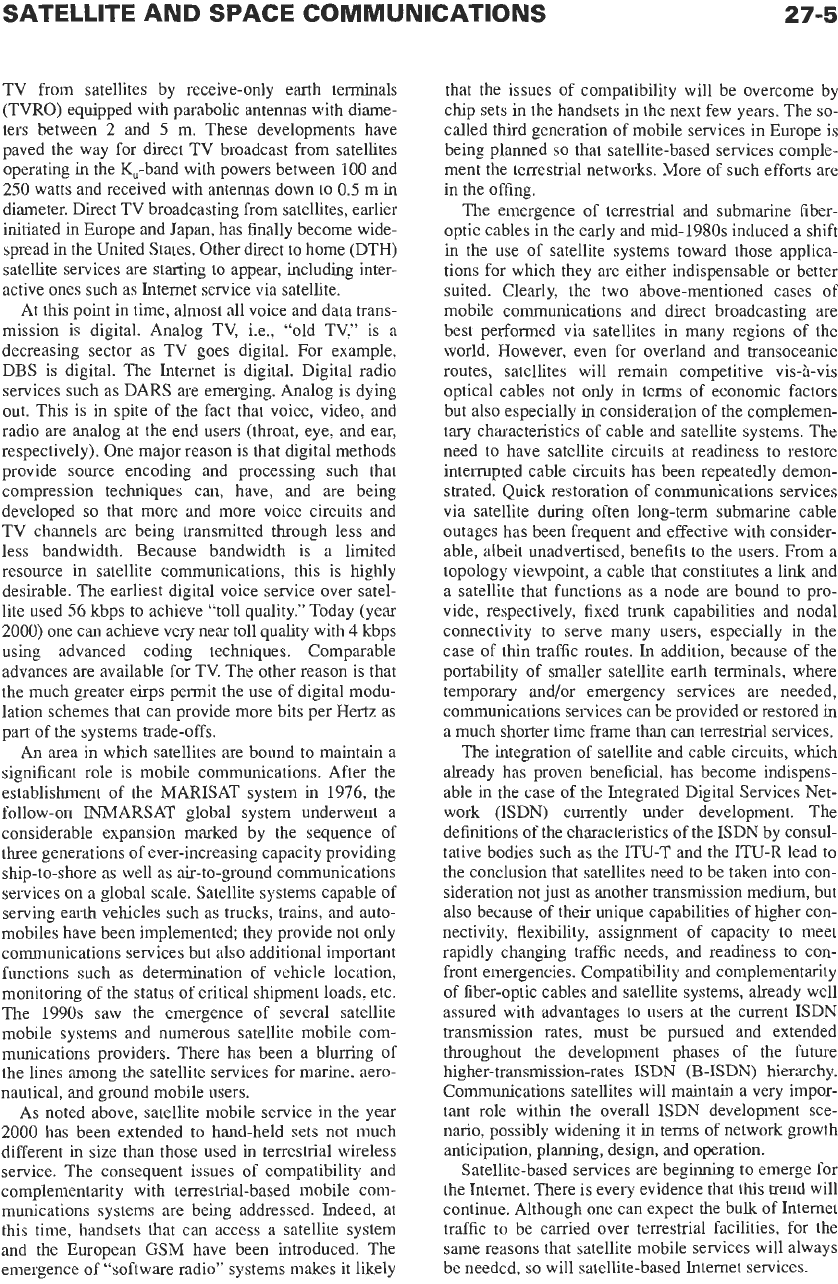
27-5
TV from satellites by receive-only earth terminals
(TVRO) equipped with parabolic antennas with diame-
ters between
2
and
5
m. These developments have
paved the way for direct TV broadcast from satellites
operating
in
the &-band with powers between
100
and
250
watts and received with antennas down to
0.5
m in
diameter. Direct TV broadcasting from satellites, earlier
initiated
in
Europe and Japan, has finally become wide-
spread
in
the United States. Other direct to home
(DTH)
satellite services
are
starting to appear, including inter-
active ones such
as
Internet service via satellite.
At this point in time, almost all voice and data trans-
mission is digital. Analog TV, Le., “old TV,” is
a
decreasing sector as TV goes digital. For example,
DBS
is
digital. The Internet is digital. Digital radio
services such
as
DARS are emerging. Analog is dying
out. This is in spite of the fact that voice, video, and
radio are analog
at
the end users (throat, eye, and ear,
respectively). One major reason is that digital methods
provide source encoding and processing such that
compression techniques can, have, and are being
developed
so
that more and more voice circuits and
TV channels are being transmitted through less and
less bandwidth. Because bandwidth is a limited
resource in satellite communications, this is highly
desirable. The earliest digital voice service over satel-
lite used
56
kbps to achieve “toll quality.” Today (year
2000)
one can achieve very near toll quality with
4
kbps
using advanced coding techniques. Comparable
advances are available for TV. The other reason is that
the much greater eirps permit the use of digital modu-
lation schemes that can provide more bits per Hertz
as
part of the systems trade-offs.
An
area in which satellites are bound to maintain
a
significant role is mobile communications. After the
establishment of the MARISAT system in 1976, the
follow-on INMARSAT global system underwent
a
considerable expansion marked by the sequence of
three generations of ever-increasing capacity providing
ship-to-shore
as
well as air-to-ground communications
services on
a
global scale. Satellite systems capable of
serving earth vehicles such as trucks, trains, and auto-
mobiles have been implemented; they provide not only
communications services but also additional important
functions such as determination of vehicle location,
monitoring of the status of critical shipment loads, etc.
The
1990s
saw the emergence of several satellite
mobile systems and numerous satellite mobile com-
munications providers. There has been
a
blurring of
the lines among the satellite services for marine, aero-
nautical, and ground mobile users.
As
noted above, satellite mobile service in the year
2000
has been extended to hand-held sets not much
different
in
size than those used in terrestrial wireless
service. The consequent issues of compatibility and
complementarity with terrestrial-based mobile com-
munications systems are being addressed. Indeed,
at
this time, handsets that can access
a
satellite system
and the European
GSM
have been introduced. The
emergence of “software radio” systems makes it likely
that the issues of compatibility will be overcome by
chip sets in the handsets in the next few years. The
so-
called third generation of mobile services in Europe is
being planned
so
that satellite-based services comple-
ment the terrestrial networks. More of such efforts are
in the offing.
The emergence of terrestrial and submarine fiber-
optic cables in the early and mid-1980s induced a shift
in the use of satellite systems toward those applica-
tions for which they are either indispensable or better
suited. Clearly, the two above-mentioned cases
of
mobile communications and direct broadcasting are
best performed via satellites in many regions
of
the
world. However, even for overland and transoceanic
routes, satellites will remain competitive vis-&-vis
optical cables not only in terms of economic factors
but also especially in consideration of the complemen-
tary characteristics of cable and satellite systems. The
need to have satellite circuits at readiness to restore
interrupted cable circuits has been repeatedly demon-
strated. Quick restoration of communications services
via satellite during often long-term submarine cable
outages has been frequent and effective with consider-
able, albeit unadvertised, benefits to the users. From
a
topology viewpoint,
a
cable that constitutes
a
link and
a
satellite that functions
as
a
node are bound
to
pro-
vide, respectively, fixed trunk capabilities and nodal
connectivity to serve many users, especially in the
case of thin traffic routes.
In
addition, because of the
portability of smaller satellite earth terminals, where
temporary and/or emergency services are needed,
communications services can be provided or restored in
a
much shorter time frame than can terrestrial services.
The integration of satellite and cable circuits, which
already has proven beneficial, has become indispens-
able in the case of the Integrated Digital Services Net-
work (ISDN) currently under development. The
definitions of the characteristics of the ISDN by consul-
tative bodies such
as
the ITU-T and the ITU-R lead to
the conclusion that satellites need to be taken into con-
sideration not just
as
another transmission medium, but
also because of their unique capabilities
of
higher con-
nectivity, flexibility, assignment of capacity to meet
rapidly changing traffic needs, and readiness
to
con-
front emergencies. Compatibility and complementarity
of fiber-optic cables and satellite systems, already well
assured with advantages to users at the current ISDN
transmission rates, must be pursued and extended
throughout
the
development phases
of
the future
higher-transmission-rates
ISDN
(B-ISDN)
hierarchy.
Communications satellites will maintain
a
very impor-
tant role within the overall
ISDN
development sce-
nario, possibly widening it in terms of network growth
anticipation, planning, design, and operation.
Satellite-based services are beginning to emerge for
the Internet. There is every evidence that this trend will
continue. Although one can expect the bulk of Internet
traffic
to
be carried over terrestrial facilities, for the
same reasons that satellite mobile services will always
be needed,
so
will satellite-based Internet services.
